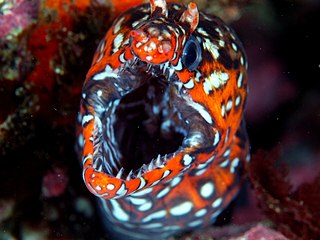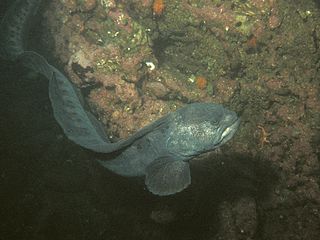
The saccopharyngiformes are a derived lineage of unusual eels within the order Anguilliformes, and includes families Cyematidae, Monognathidae, Eurypharyngidae, Saccopharyngidae, and the proposed family Neocyematidae. Most of the fish in this group are deep-dwelling and rarely seen, typically known from only a handful of specimens. Species include recognizable fish such as pelican eels, bobtail eels, and gulper eels. Some can live deep in the ocean, well into the aphotic zone, approximately 500–1800 meters deep. Extensive research has not been conducted on them due to being indirectly observed, with some species known only from their larvae. All families except for the exceptionally rare individuals of proposed family Neoceymatidae are found in all major oceans.

Moray eels, or Muraenidae, are a family of eels whose members are found worldwide. There are approximately 200 species in 15 genera which are almost exclusively marine, but several species are regularly seen in brackish water, and a few are found in fresh water.

The dusky smooth-hound, also called the smooth dogfish or the dog shark, is a species of houndshark in the family Triakidae. This shark is an olive grey or brown in color, and may have shades of yellow or grayish white. Females live to 16 years and males have a lifespan of 10 years. M. canis was the first shark recognised to have viral infections.

Needlefish or long toms are piscivorous fishes primarily associated with very shallow marine habitats or the surface of the open sea. Some genera include species found in marine, brackish, and freshwater environments, while a few genera are confined to freshwater rivers and streams, including Belonion, Potamorrhaphis, and Xenentodon. Needlefish closely resemble North American freshwater gars in being elongated and having long, narrow jaws filled with sharp teeth, and some species of needlefishes are referred to as gars or garfish despite being only distantly related to the true gars. In fact, the name "garfish" was originally used for the needlefish Belone belone in Europe and only later applied to the North American fishes by European settlers during the 18th century.

The pelican eel is a deep-sea eel rarely seen by humans, though it is occasionally caught in fishing nets. It is the only known member of the genus Eurypharynx and the family Eurypharyngidae. It belongs to the "saccopharyngiforms", members of which were historically placed in their own order, but are now considered true eels in the order Anguilliformes. The pelican eel has been described by many synonyms, yet nobody has been able to demonstrate that more than one species of pelican eel exists. It is also referred to as the gulper eel, pelican gulper, and umbrella-mouth gulper. The specific epithet pelecanoides refers to the pelican, as the fish's large mouth is reminiscent of that of the pelican.

The slender snipe eel is a fish that can weigh only a few ounces, yet reach 5 feet or 1.5 m in length. Features include a bird-like beak with curving tips, covered with tiny hooked teeth, which they use to sweep through the water to catch shrimp and other crustaceans. It has a lifespan of ten years.

Demersal fish, also known as groundfish, live and feed on or near the bottom of seas or lakes. They occupy the sea floors and lake beds, which usually consist of mud, sand, gravel or rocks. In coastal waters they are found on or near the continental shelf, and in deep waters they are found on or near the continental slope or along the continental rise. They are not generally found in the deepest waters, such as abyssal depths or on the abyssal plain, but they can be found around seamounts and islands. The word demersal comes from the Latin demergere, which means to sink.

Snipe eels are a family, Nemichthyidae, of eels that consists of nine species in three genera. They are pelagic fishes, found in every ocean, mostly at depths of 300–600 m but sometimes as deep as 4000 m. Depending on the species, adults may reach 1–2 m (39–79 in) in length, yet they weigh only 80-400 g. They are distinguished by their very slender jaws that separate toward the tips as the upper jaw curves upward. The jaws appear similar to the beak of the bird called the snipe. Snipe eels are oviparous, and the juveniles, called Leptocephali, do not resemble the adults but have oval, leaf-shaped and transparent bodies. Different species of snipe eel have different shapes, sizes and colors. The similarly named bobtail snipe eel is actually in a different family and represented by two species, the black Cyema atrum and the bright red Neocyema erythrosoma.
The bobtail snipe eels are two species of deep-sea eels in the family Cyematidae, one only in each of two genera. They are small elongate fishes, growing up to 16cm in length.
Cyema atrum is a species of deep-water bobtail snipe eel in the family Cyematidae. It is the only member of its genus Cyema. It is found globally at depths of 330 to 5,100 m. Common names include the bobtail eel, snipe eel, scissorjaw eel, and arrow eel. It grows to a possible length of 16 cm (6.3 in), based on the estimated size for other bobtail eels. There is not much information about this enigmatic fish, because it is so rare and has been encountered a small number of times, but its diet may be composed of tiny fish larvae, zooplankton, copepods, amphipods, sea snow, and tiny krill. Instead of gobbling them up, the eel uses the comb-like teeth to swipe the food from the water column by slashing the head to the sides.
Neocyema erythrosoma is a species of pelagic fish, a deep-water bobtail snipe eel in the family Cyematidae. It is the only member of its genus, Neocyema. It was first described by Peter Castle in 1978 after two specimens were caught at great depths in the south Atlantic Ocean in 1971. Further specimens have since been caught in the North Atlantic.
Leptocephalus is a genus that was used for species of larval eels, called leptocephali, that were thought to be new fish species, or whose adult eel species were not known. Leptocephali differ so much in appearance from their adults that the larvae and adults of eels are not easily matched, and when first discovered, leptocephali were thought to be a distinct type of fishes, but not eels. Because of this, the genus designation of Leptocephalus was used for a while for unidentified leptocephali even after it was known that these were the larvae of eels thus becoming a "wastebasket taxon", but this practice is no longer used. Examples of marine congrid larvae, found in the western Indian Ocean and the Red Sea that were named this way are listed below. Only two species in two families are currently treated as having any validity, though the validity of L. bellottii is strongly in doubt.

The lesser sand eel or sand lance is a species of fish in the sand lance family Ammodytidae. It is an elongated cylindrical fish which may be up to 20 centimetres (7.9 in) long.

The leopard moray eel or dragon moray, is a species of marine fish in the family Muraenidae.

The wolf eel is a species of wolffish (Anarhichadidae) from the North Pacific. It is monotypic within the genus Anarrhichthys and one of only two genera in the family, the other being Anarhichas.

Stemonidium hypomelas is a species of deep-sea eel in the family Serrivomeridae, originally described from a 171-mm specimen taken from a depth of around 1,000 m near Niihau Island, Hawaii in 1902. It can be distinguished from the related sawtooth eels by its reduced dentition, which more resemble those of the snipe eel. It is of no significance to fisheries.

Coral reef fish are fish which live amongst or in close relation to coral reefs. Coral reefs form complex ecosystems with tremendous biodiversity. Among the myriad inhabitants, the fish stand out as colourful and interesting to watch. Hundreds of species can exist in a small area of a healthy reef, many of them hidden or well camouflaged. Reef fish have developed many ingenious specialisations adapted to survival on the reefs.
Nemichthys is a genus of eels in the snipe-eel family Nemichthyidae. It currently contains the following species:

Most bony fishes have two sets of jaws made mainly of bone. The primary oral jaws open and close the mouth, and a second set of pharyngeal jaws are positioned at the back of the throat. The oral jaws are used to capture and manipulate prey by biting and crushing. The pharyngeal jaws, so-called because they are positioned within the pharynx, are used to further process the food and move it from the mouth to the stomach.

The Bean's sawtooth eel is an eel in the family Nemichthyidae. It was described by Theodore Gill and John Adam Ryder in 1883. It is a marine, deep water-dwelling eel which is known from throughout the Atlantic Ocean, the Indian Ocean, and the Western Pacific Ocean, including Iceland, South Africa, Réunion, and Australia. It dwells at a depth range of 0–5998 metres, and leads a solitary lifestyle. It migrates vertically at night. Males can reach a maximum total length of 78-80 centimetres, making it the largest sawtooth eel.















